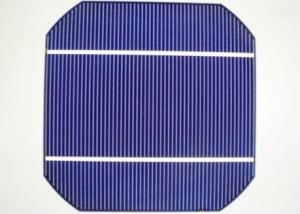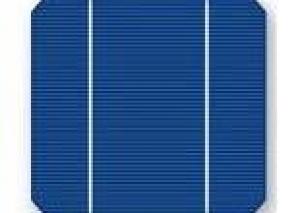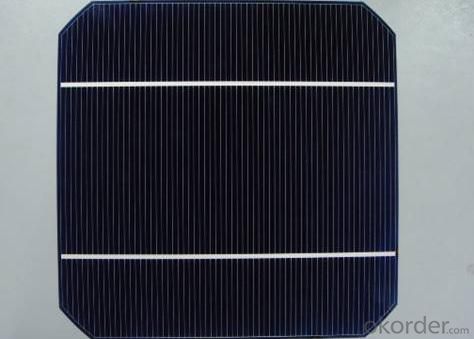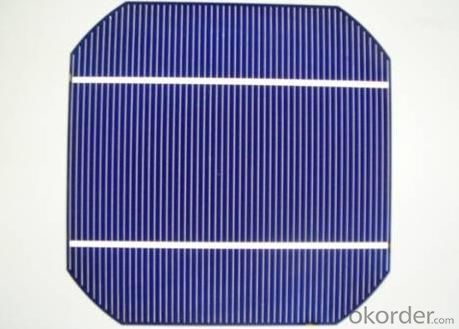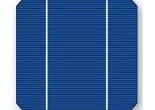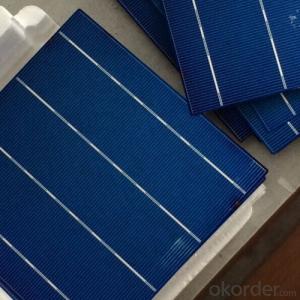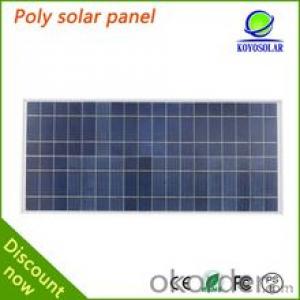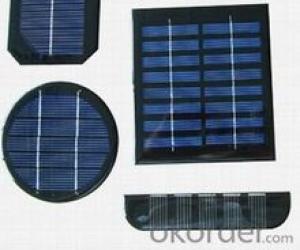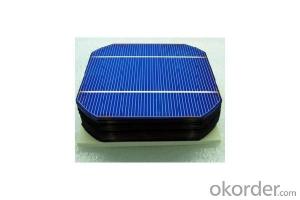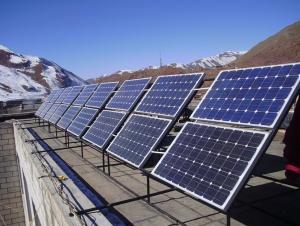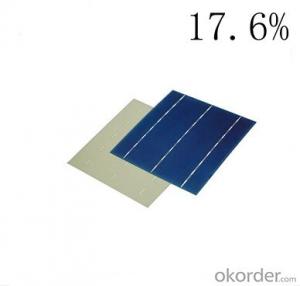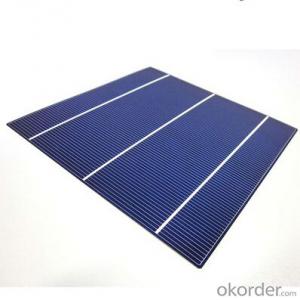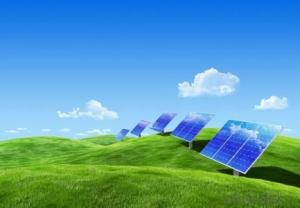Well Design High Efficiency Monocrystalline Silicon Solar Cells for Energy Transfer
- Loading Port:
- Tianjin
- Payment Terms:
- TT or LC
- Min Order Qty:
- 1200 watt
- Supply Capability:
- 700 watt/month
OKorder Service Pledge
OKorder Financial Service
You Might Also Like
Mechanical data and design of High Efficiency Monocrystalline Silicon Solar Cells
Format 125mm × 125mm ± 0.5 mm
Thickness- 210 μm ± 40 μm
Front (-) 1.6mm bus bars (silver),blue anti-reflection coating (silicon nitride)
Back (+) 2.5mm wide soldering pads (silver) back surface field (aluminium)
Temperature Coefficient of Cells
Voc. Temp .coef.%/K -0.35%/K
Isc . Temp .coef.%/K +0.024%/K
Pm. Temp. coef.%/K -0.47%/K
Electrical Characteristic
Efficiency (%) Pmpp (W) Umpp (V) Impp (A) Uoc (V) Isc (A) FF (%)
18.35 2.841 0.532 5.342 0.631 5.67 79.41%
18.2 2.817 0.53 5.319 0.631 5.64 79.16%
18.05 2.794 0.527 5.301 0.63 5.63 78.77%
17.9 2.771 0.527 5.259 0.629 5.62 78.39%
17.75 2.748 0.526 5.224 0.629 5.61 77.88%
17.6 2.725 0.524 5.201 0.629 5.59 77.50%
17.45 2.702 0.52 5.196 0.629 5.586 76.90%
17.3 2.678 0.516 5.183 0.626 5.577 76.71%
17.15 2.655 0.513 5.175 0.623 5.565 76.58%
17 2.632 0.51 5.161 0.622 5.559 76.12%
16.75 2.593 0.508 5.103 0.615 5.477 76.98%
16.5 2.555 0.506 5.047 0.608 5.396 77.88%
Brief introduction of Photovoltaic Cells Solar Panels
Photovoltaic Cells Solar Panels convert the solar radiation through the photoelectric effect or photochemical effect directly or indirectly into electrical energy by absorbing sunlight; the main material for most solar panels is silicon, but the production cost is so great that it cannot be a large number of widely and commonly used. Compared with ordinary batteries and rechargeable batteries, solar cells belong to more energy saving green products.
Advantages of Photovoltaic Cells Solar Panels
1) Solar energy resources are inexhaustible; solar energy shine on the planet currently consumes is 6,000 times larger than humanity to. Spread on Earth and the solar widespread, there are only local illumination can use solar photovoltaic panels, unrestricted area, elevation and other factors.
2), Solar energy resources are available everywhere, the nearest power supply. Without long-distance walks, preventing long-distance power transmission lines formed off the loss, but also has a throttling transmission costs. This is also the use of solar photovoltaic panels supplied premise transmission inconvenient western planning.
3), Energy conversion process of Photovoltaic Cells Solar Panels generating electricity is brief, which is a direct transition from photons to electrons. There is no central process (thermal energy into mechanical energy, mechanical energy is converted to electromagnetic energy, etc.) and mechanical activity, there is no mechanical wear. Based on thermodynamic analysis, Photovoltaic Cells Solar Panels generation with high theoretical efficiency, up to 80%, technology has great potential to develop.
4), Photovoltaic Cells Solar Panels do not use the fuel itself, does not emit any greenhouse gases and other substances, including gas, polluting air and noise, the impact will not suffer an energy crisis or the formation of the fuel market, is the real green environmental protection, new renewable energy sources.
5), Photovoltaic Cells Solar Panels generate electricity without cooling water process, the device may be in the desolate desert without water. PV can also be conveniently associated with the construction material, the composition of the construction of photovoltaic power generation system integration, covering not demand alone can choke precious resource site.
6), Photovoltaic Cells Solar Panels generate electricity without mechanical transmission components, operation, and maintenance simple, reliable operation of the same. A PV system only has a solar cell module can generate electricity, coupled with automatic control technology widely used; it can be done simply on unattended, low maintenance costs.
7), Photovoltaic Cells Solar Panels generate electricity tasking reliable, the service life (over 30 years). Crystalline silicon solar battery life is up to 20 to 35 years. In the photovoltaic power generation system, the only rational design, modeling appropriate battery life can last up to 10 to 15 years.
8), Photovoltaic Cells Solar Panels have simple structure, small size, light weight, easy to transport and installations. PV systems establish a short cycle, electricity load capacity vary, convenient and sensitive, easily combined expansion.
- Q: What is the efficiency of solar cells?
- The efficiency of solar cells refers to the percentage of sunlight that can be converted into usable electricity. It varies depending on the type of solar cell technology used, but current commercial solar cells typically have an efficiency range of 15% to 22%. However, research and development efforts are continuously improving solar cell efficiency, with some laboratory prototypes achieving efficiencies exceeding 40%.
- Q: Are solar cells affected by pollution?
- Yes, solar cells can be affected by pollution. Air pollution, such as smog and particulate matter, can reduce the efficiency of solar cells by blocking sunlight and reducing the amount of light that reaches the cells. Additionally, pollutants can settle on the surface of solar panels, creating a layer that reduces their ability to generate electricity.
- Q: Can solar cells be used for indoor applications?
- Yes, solar cells can be used for indoor applications. However, their efficiency is significantly reduced compared to outdoor use due to limited access to direct sunlight. Indoor solar cells can still generate electricity from artificial light sources, but they are typically less productive and may require additional lighting to optimize their performance.
- Q: Can solar cells be used in camping or outdoor recreational activities?
- Yes, solar cells can be used in camping or outdoor recreational activities. They are portable and can be easily carried while camping, hiking, or engaging in other outdoor activities. Solar cells can charge various devices such as phones, cameras, and portable speakers, ensuring that you have power even in remote locations where traditional electricity sources may not be available.
- Q: How do solar cells perform in low-light conditions?
- Solar cells perform less efficiently in low-light conditions compared to bright sunlight. This is because they rely on the energy from photons in sunlight to generate electricity. In low-light conditions, such as on cloudy days or during sunrise and sunset, the number of photons reaching the solar cells decreases. As a result, the conversion of light energy into electrical energy is reduced, leading to lower power output. However, advancements in solar cell technology have improved their performance in low-light conditions, enabling them to generate some electricity even in dim lighting.
- Q: Can solar cells be used for disaster relief efforts?
- Yes, solar cells can be effectively used for disaster relief efforts. Solar cells provide a reliable and sustainable source of energy, which is crucial during emergencies when conventional power sources may be disrupted or unavailable. Solar cells can power essential devices such as lighting, communication equipment, and medical devices in disaster-stricken areas, improving response and recovery operations. Moreover, solar-powered systems can be quickly deployed and are cost-effective in the long run, making them an ideal solution for disaster relief efforts.
- Q: What is the internal structure of solar panels
- Very low, but the photoelectric conversion efficiency relative to the crystalline silicon cell more than half of the point, but the low light effect is very good, in the ordinary light can also generate electricity, such as the calculator on the solar cell.
- Q: What are the main components of a solar cell?
- The main components of a solar cell are a semiconductor material, typically silicon, which absorbs sunlight and generates electricity; metal contacts that collect and carry the generated electricity; and a protective layer, usually made of glass or plastic, to shield the semiconductor material from external factors.
- Q: How do solar cells compare to fossil fuels in terms of energy production?
- Solar cells are a cleaner and more sustainable source of energy compared to fossil fuels. While fossil fuels release harmful emissions and contribute to climate change, solar cells harness the power of the sun to generate electricity without any pollution. Although fossil fuels have been the dominant source of energy for decades, solar cells offer a viable alternative that is continuously improving in efficiency and cost-effectiveness.
- Q: Can solar cells be used for water heating?
- Yes, solar cells can be used for water heating. Solar thermal panels, also known as solar water heaters, use solar cells to convert sunlight into heat energy, which is then used to heat water for various applications such as domestic hot water or space heating.
1. Manufacturer Overview
| Location | Zhejiang, China |
| Year Established | 2008 |
| Annual Output Value | Above US$ 320 Million |
| Main Markets | Australia; Asia; South East Asia; South America; North America; Europe; Africa |
| Company Certifications | ISO 9001:2008; CE; TUV; UL |
2. Manufacturer Certificates
| a) Certification Name | |
| Range | |
| Reference | |
| Validity Period |
3. Manufacturer Capability
| a) Trade Capacity | |
| Nearest Port | Ningbo, China |
| Export Percentage | 45% - 50% |
| No.of Employees in Trade Department | 200-300 People |
| Language Spoken: | English; Chinese |
| b) Factory Information | |
| Factory Size: | Above 10,000 Square meter |
| No. of Production Lines | 8 |
| Contract Manufacturing | OEM Service Offered; Design Service Offered |
| Product Price Range | Average |
Send your message to us
Well Design High Efficiency Monocrystalline Silicon Solar Cells for Energy Transfer
- Loading Port:
- Tianjin
- Payment Terms:
- TT or LC
- Min Order Qty:
- 1200 watt
- Supply Capability:
- 700 watt/month
OKorder Service Pledge
OKorder Financial Service
Similar products
Hot products
Hot Searches
Related keywords


